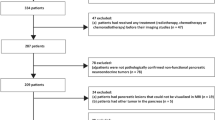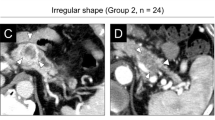Abstract
Objectives
To identify PanNEN imaging features associated with tumor grade and aggressive histopathological features.
Methods
Associations between histopathological and imaging features of resected PanNEN were retrospectively tested. Histopathologic features included WHO grade, lymphovascular invasion (LVI), growth pattern (infiltrative, circumscribed), and intratumoral fibrosis (mature, immature). Imaging features included size, degree/uniformity of enhancement, progressive enhancement, contour, infiltrative appearance (infiltrativeim), calcifications, cystic components, tumor thrombus, vascular occlusion (VO), duct dilatation, and atrophy. Multinomial logistic regression analyses evaluated the magnitude of associations. Association of variables with outcome was assessed using Cox-proportional hazards regression.
Results
133 patients were included. 3 imaging features (infiltrativeim, ill-defined contour [contourill], and VO) were associated with all histopathologic parameters and poor outcome. Increase in grade increased odds of contourill by 15.6 times (p = 0.0001, 95% CI 3.8–64.4). PanNEN with VO were 51.1 times (p = 0.0002, 6.5–398.6) more likely to demonstrate LVI. For PanNEN with contourill, infiltrative growth pattern was 51.3 times (p < 0.0001, 9.1–288.4), and fibrosis was 14 times (p = 0.0065, 2.1–93.7) more likely. Contourill was associated with decreased recurrence-free survival (p = 0.0003, HR 18.29, 3.83–87.3) and VO (p = 0.0004, HR6.08, 2.22–16.68) with decreased overall survival.
Conclusions
Infiltrativeim, contourill, and VO on imaging are associated with higher grade/histopathological parameters linked to tumor aggression, and poor outcome.




Similar content being viewed by others
References
Taskin, O.C., C.N. Clarke, M. Erkan, S. Tsai, D.B. Evans, and V. Adsay, (2020) Pancreatic neuroendocrine neoplasms: current state and ongoing controversies on terminology, classification and prognostication. J Gastrointest Oncol. 11(3): p. 548-558 DOI: https://doi.org/10.21037/jgo.2020.03.07.
Chatterjee, D., N.A. Trikalinos, G.A. Williams, J. Liu, W.G. Hawkins, and C. Hammill, (2020) Intratumoral Fibrosis and Tumor Growth Pattern as Prognostic Factors in Optimally Resected Pancreatic Neuroendocrine Neoplasms: An Analysis of 168 Cases. Pancreas. 49(2): p. 255-260 DOI: https://doi.org/10.1097/MPA.0000000000001478.
Johnson, A., J.P. Wright, Z. Zhao, T. Komaya, A. Parikh, N. Merchant, and C. Shi, (2015) Cadherin 17 is frequently expressed by 'sclerosing variant' pancreatic neuroendocrine tumour. Histopathology. 66(2): p. 225-33 DOI: https://doi.org/10.1111/his.12535.
Paiella, S., L. Landoni, R. Rota, M. Valenti, G. Elio, S.F. Crino, E. Manfrin, A. Parisi, S. Cingarlini, M. D'Onofrio, A. Scarpa, R.T. Lawlor, L. Bernardoni, P. Capelli, C. Nessi, M. Miotto, A. Gabbrielli, C. Bassi, and R. Salvia, (2020) Endoscopic ultrasound-guided fine-needle aspiration for the diagnosis and grading of pancreatic neuroendocrine tumors: a retrospective analysis of 110 cases. Endoscopy DOI: https://doi.org/10.1055/a-1180-8614.
Hwang, H.S., Y. Kim, S. An, S.J. Kim, J.Y. Kim, S.Y. Kim, D.W. Hwang, D.H. Park, S.S. Lee, S.C. Kim, D.W. Seo, and S.M. Hong, (2018) Grading by the Ki-67 Labeling Index of Endoscopic Ultrasound-Guided Fine Needle Aspiration Biopsy Specimens of Pancreatic Neuroendocrine Tumors Can Be Underestimated. Pancreas. 47(10): p. 1296-1303 DOI: https://doi.org/10.1097/MPA.0000000000001157.
Lee, N.J., R.H. Hruban, and E.K. Fishman, (2018) Pancreatic neuroendocrine tumor: review of heterogeneous spectrum of CT appearance. Abdom Radiol (NY). 43(11): p. 3025-3034 DOI: https://doi.org/10.1007/s00261-018-1574-4.
Rodallec, M., V. Vilgrain, A. Couvelard, P. Rufat, D. O'Toole, V. Barrau, A. Sauvanet, P. Ruszniewski, and Y. Menu, (2006) Endocrine pancreatic tumours and helical CT: contrast enhancement is correlated with microvascular density, histoprognostic factors and survival. Pancreatology. 6(1-2): p. 77-85 DOI: https://doi.org/10.1159/000090026.
d'Assignies, G., A. Couvelard, S. Bahrami, M.P. Vullierme, P. Hammel, O. Hentic, A. Sauvanet, P. Bedossa, P. Ruszniewski, and V. Vilgrain, (2009) Pancreatic endocrine tumors: tumor blood flow assessed with perfusion CT reflects angiogenesis and correlates with prognostic factors. Radiology. 250(2): p. 407-16 DOI: https://doi.org/10.1148/radiol.2501080291.
Kim, C., J.H. Byun, S.M. Hong, S. An, J.H. Kim, S.S. Lee, and H.J. Kim, (2017) A comparison of enhancement patterns on dynamic enhanced CT and survival between patients with pancreatic neuroendocrine tumors with and without intratumoral fibrosis. Abdom Radiol (NY). 42(12): p. 2835-2842 DOI: https://doi.org/10.1007/s00261-017-1212-6.
Yano, M., S. Misra, D.H. Carpenter, A. Salter, and C.F. Hildebolt, (2017) Pancreatic Neuroendocrine Tumors: Computed Tomography Enhancement, But Not Histological Grade, Correlates With Tumor Aggression. Pancreas. 46(10): p. 1366-1372 DOI: https://doi.org/10.1097/MPA.0000000000000922.
Choi, T.W., J.H. Kim, M.H. Yu, S.J. Park, and J.K. Han, (2018) Pancreatic neuroendocrine tumor: prediction of the tumor grade using CT findings and computerized texture analysis. Acta Radiol. 59(4): p. 383-392 DOI: https://doi.org/10.1177/0284185117725367.
Yang, B., H.Y. Chen, X.Y. Zhang, Y. Pan, Y.F. Lu, and R.S. Yu, (2020) The prognostic value of multidetector CT features in predicting overall survival outcomes in patients with pancreatic neuroendocrine tumors. Eur J Radiol. 124: p. 108847 DOI: https://doi.org/10.1016/j.ejrad.2020.108847.
Salahshour, F., M.M. Mehrabinejad, A. Zare Dehnavi, A. Alibakhshi, H. Dashti, M.A. Ataee, and N. Ayoobi Yazdi, (2020) Pancreatic neuroendocrine tumors (pNETs): the predictive value of MDCT characteristics in the differentiation of histopathological grades. Abdom Radiol (NY) DOI: https://doi.org/10.1007/s00261-019-02372-x.
Li, W.X., F. Miao, X.Q. Xu, J. Zhang, Z.Y. Wu, K.M. Chen, F.H. Yan, and X.Z. Lin, (2020) Pancreatic Neuroendocrine Neoplasms: CT Spectral Imaging in Grading. Acad Radiol DOI: https://doi.org/10.1016/j.acra.2020.01.033.
Bian, Y., Z. Zhao, H. Jiang, X. Fang, J. Li, K. Cao, C. Ma, S. Guo, L. Wang, G. Jin, J. Lu, and J. Xu, (2020) Noncontrast Radiomics Approach for Predicting Grades of Nonfunctional Pancreatic Neuroendocrine Tumors. J Magn Reson Imaging DOI: https://doi.org/10.1002/jmri.27176.
Canellas, R., K.S. Burk, A. Parakh, and D.V. Sahani, (2018) Prediction of Pancreatic Neuroendocrine Tumor Grade Based on CT Features and Texture Analysis. AJR Am J Roentgenol. 210(2): p. 341-346 DOI: https://doi.org/10.2214/AJR.17.18417.
Kato, T., A. Kudo, Y. Kinowaki, Y. Ishikawa, S. Watanabe, K. Akahoshi, K. Ogawa, H. Ono, D. Ban, S. Tanaka, and M. Tanabe, (2021) A novel classification of portal venous tumor invasion to predict residual tumor status after surgery in patients with pancreatic neuroendocrine neoplasms. J Cancer Res Clin Oncol DOI: https://doi.org/10.1007/s00432-021-03660-0.
Tatsumoto, S., Y. Kodama, Y. Sakurai, T. Shinohara, A. Katanuma, and H. Maguchi, (2013) Pancreatic neuroendocrine neoplasm: correlation between computed tomography enhancement patterns and prognostic factors of surgical and endoscopic ultrasound-guided fine-needle aspiration biopsy specimens. Abdom Imaging. 38(2): p. 358-66 DOI: https://doi.org/10.1007/s00261-012-9953-8.
Shi, C., S.S. Siegelman, S. Kawamoto, C.L. Wolfgang, R.D. Schulick, A. Maitra, and R.H. Hruban, (2010) Pancreatic duct stenosis secondary to small endocrine neoplasms: a manifestation of serotonin production? Radiology. 257(1): p. 107-14 DOI: https://doi.org/10.1148/radiol.10100046.
Sallinen, V., C. Haglund, and H. Seppanen, (2015) Outcomes of resected nonfunctional pancreatic neuroendocrine tumors: Do size and symptoms matter? Surgery. 158(6): p. 1556-63 DOI: https://doi.org/10.1016/j.surg.2015.04.035.
Takaji, R., S. Matsumoto, H. Mori, Y. Yamada, N. Hongo, S. Tanoue, M. Ota, S. Kitano, and K. Fukuzawa, (2009) Carcinoid tumors of the pancreas: dynamic CT and MRI features with pathological correlation. Abdom Imaging. 34(6): p. 753-8 DOI: https://doi.org/10.1007/s00261-008-9470-y.
Wang, Y., Z.E. Chen, V. Yaghmai, P. Nikolaidis, R.J. McCarthy, L. Merrick, and F.H. Miller, (2011) Diffusion-weighted MR imaging in pancreatic endocrine tumors correlated with histopathologic characteristics. J Magn Reson Imaging. 33(5): p. 1071-9 DOI: https://doi.org/10.1002/jmri.22541.
McCall, C.M., C. Shi, A.P. Klein, B. Konukiewitz, B.H. Edil, T.A. Ellison, C.L. Wolfgang, R.D. Schulick, G. Kloppel, and R.H. Hruban, (2012) Serotonin expression in pancreatic neuroendocrine tumors correlates with a trabecular histologic pattern and large duct involvement. Hum Pathol. 43(8): p. 1169-76 DOI: https://doi.org/10.1016/j.humpath.2011.09.014.
Chorti, A., T.S. Papavramidis, and A. Michalopoulos, (2016) Calcifying Fibrous Tumor: Review of 157 Patients Reported in International Literature. Medicine (Baltimore). 95(20): p. e3690 DOI: https://doi.org/10.1097/MD.0000000000003690.
Poultsides, G.A., L.C. Huang, Y. Chen, B.C. Visser, R.K. Pai, R.B. Jeffrey, W.G. Park, A.M. Chen, P.L. Kunz, G.A. Fisher, and J.A. Norton, (2012) Pancreatic neuroendocrine tumors: radiographic calcifications correlate with grade and metastasis. Ann Surg Oncol. 19(7): p. 2295-303 DOI: https://doi.org/10.1245/s10434-012-2305-7.
McGovern, J.M., A.D. Singhi, A.A. Borhani, A. Furlan, K.M. McGrath, H.J. Zeh, 3rd, N. Bahary, and A.K. Dasyam, (2018) CT Radiogenomic Characterization of the Alternative Lengthening of Telomeres Phenotype in Pancreatic Neuroendocrine Tumors. AJR Am J Roentgenol. 211(5): p. 1020-1025 DOI: https://doi.org/10.2214/AJR.17.19490.
D'Onofrio, M., V. Ciaravino, N. Cardobi, R. De Robertis, S. Cingarlini, L. Landoni, P. Capelli, C. Bassi, and A. Scarpa, (2019) CT Enhancement and 3D Texture Analysis of Pancreatic Neuroendocrine Neoplasms. Sci Rep. 9(1): p. 2176 DOI: https://doi.org/10.1038/s41598-018-38459-6.
Howe, J.R., N.B. Merchant, C. Conrad, X.M. Keutgen, J. Hallet, J.A. Drebin, R.M. Minter, T.C. Lairmore, J.F. Tseng, H.J. Zeh, S.K. Libutti, G. Singh, J.E. Lee, T.A. Hope, M.K. Kim, Y. Menda, T.R. Halfdanarson, J.A. Chan, and R.F. Pommier, (2020) The North American Neuroendocrine Tumor Society Consensus Paper on the Surgical Management of Pancreatic Neuroendocrine Tumors. Pancreas. 49(1): p. 1-33 DOI: https://doi.org/10.1097/MPA.0000000000001454.
Falconi, M., D.K. Bartsch, B. Eriksson, G. Kloppel, J.M. Lopes, J.M. O'Connor, R. Salazar, B.G. Taal, M.P. Vullierme, D. O'Toole, and p. Barcelona Consensus Conference, (2012) ENETS Consensus Guidelines for the management of patients with digestive neuroendocrine neoplasms of the digestive system: well-differentiated pancreatic non-functioning tumors. Neuroendocrinology. 95(2): p. 120-34 DOI: https://doi.org/10.1159/000335587.
Network, N.C.C., (2021) Clinical Practice Guidelines in Oncology, Neuroendocrine and Adrenal Tumors, Version 3.2021.
Soczomski, P., B. Jurecka-Lubieniecka, A. Krzywon, A.J. Cortez, S. Zgliczynski, N. Rogozik, M. Oczko-Wojciechowska, A. Pawlaczek, T. Bednarczuk, and B. Jarzab, (2021) A Direct Comparison of Patients With Hereditary and Sporadic Pancreatic Neuroendocrine Tumors: Evaluation of Clinical Course, Prognostic Factors and Genotype-Phenotype Correlations. Front Endocrinol (Lausanne). 12: p. 681013 DOI: https://doi.org/10.3389/fendo.2021.681013.
Funding
None.
Author information
Authors and Affiliations
Corresponding author
Additional information
Publisher's Note
Springer Nature remains neutral with regard to jurisdictional claims in published maps and institutional affiliations.
Rights and permissions
About this article
Cite this article
Yano, M., Shetty, A.S., Williams, G.A. et al. Qualitative imaging features of pancreatic neuroendocrine neoplasms predict histopathologic characteristics including tumor grade and patient outcome. Abdom Radiol 47, 3971–3985 (2022). https://doi.org/10.1007/s00261-022-03430-7
Received:
Revised:
Accepted:
Published:
Issue Date:
DOI: https://doi.org/10.1007/s00261-022-03430-7




